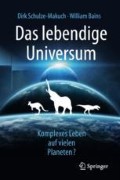Zusammenfassung
Wir hoffen, dass wir bisher überzeugend darlegen konnten, dass viele der Dinge, die komplexe Organismen wie wir besitzen – eukaryotische Zellen, Mehrzelligkeit, Sex – und andere, von denen wir abhängig sind, wie Sauerstoff, wahrscheinliche Folgen des Lebens sind, nachdem es sich auf der Erde vor 3,5 Mrd. Jahren entwickelt hatte. Aber das Auftauchen großer Organismen haben wir bisher kaum erwähnt. Wie sieht es mit Krebsen, Dinosauriern und Bäumen aus?
Access this chapter
Tax calculation will be finalised at checkout
Purchases are for personal use only
Weiterführende Literatur
Die kambrische Explosion
Graham, L. E., Cook, M. R., & Busse, J. S. (2000). The origin of plants: Body plan changes contributing to a major evolutionary radiation. Proceedings of the National Academy of Sciences, 97, 4535–4540.
Levinton, J. S. (1993). Die explosive Entfaltung der Tierwelt im Kambrium. Spektrum der Wissenschaft, 1, 54.
Levinton, J. S. (2008). The Explosion in Cambrian: How do we use the evidence. BioScience, 58, 855–864.
Morris, S. C. (1993). The fossil record and the early evolution of the Metazoa. Nature, 361, 219–225.
Präkambrische Tiere
Ivantsov, Y. (2013). Trace fossils of Precambrian metazoans “Vendobionta” and “Mollusks”. Stratigraphy and Geological Correlation, 21, 252–264.
Narbonne, G. M. (2005). The Ediacara biota: Neoproterozoic origin of animals and their ecosystems. Annual Review of Earth and Planetary Sciences, 33, 421–442.
Die Evolution der Genetik komplexer Organismen
Parfrey, L. W., Lahr, D. J. G., Knoll, A. H., & Katz, L. A. (2011). Estimating the timing of early eukaryotic diversification with multigene molecular clocks. Proceedings of the National Academy of Sciences, 108, 13624–13629.
Richter, D. J., & King, N. (2013). The genomic and cellular foundations of animal origins. Annual Review of Genetics, 47, 509–537.
Wilkins, A. (2002). The evolution of developmental pathways. Sunderland: Sinauer Associates.
Die Entstehung spezifischer Organe und Gewebe
Barlow, P. W. (2008). Reflections on ‚plant neurobiology‘. BioSystems, 92, 132–147.
Dickinson, M. H., Farley, C. T., Full, R. J., Koehl, M. A. R., Kram, R., & Lehman, S. (2000). How animals move: An integrative view. Science, 288, 100–106.
Hejnol, A. (2012). Muscle’s dual origins. Nature, 487, 181–182.
Land, M. F., & Nilsson, D.-E. (2012). Animal eyes (2. Aufl.). Oxford: Oxford University Press.
Moroz, L. L., Kocot, K. M., Citarella, M. R., Dosung, S., Norekian, T. P., et al. (2014). The ctenophore genome and the evolutionary origins of neural systems. Nature, 510, 109–114.
Simon, P. (1992). The action plant: Movement and nervous behaviour in plants. Oxford: Blackwell.
Steinmetz, P. R. H., Kraus, J. E. M., Larroux, C., Hammel, J. U., Amon-Hassenzahl, A., Houliston, E., et al. (2012). Independent evolution of striated muscles in cnidarians and bilaterians. Nature, 487, 231–23.
Author information
Authors and Affiliations
Corresponding author
Rights and permissions
Copyright information
© 2019 Springer-Verlag GmbH Deutschland, ein Teil von Springer Nature
About this chapter
Cite this chapter
Schulze-Makuch, D., Bains, W. (2019). Der Aufstieg komplexer Tiere und Pflanzen. In: Das lebendige Universum. Springer, Berlin, Heidelberg. https://doi.org/10.1007/978-3-662-58430-9_9
Download citation
DOI: https://doi.org/10.1007/978-3-662-58430-9_9
Published:
Publisher Name: Springer, Berlin, Heidelberg
Print ISBN: 978-3-662-58429-3
Online ISBN: 978-3-662-58430-9
eBook Packages: Life Science and Basic Disciplines (German Language)

